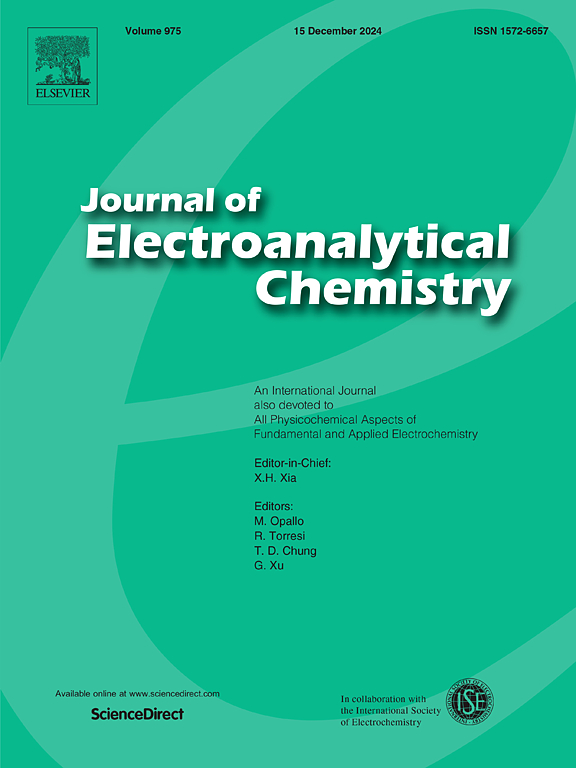Machine learning-driven prediction and optimization of selective glycerol electrocatalytic reduction into propanediols
IF 4.1
3区 化学
Q1 CHEMISTRY, ANALYTICAL
引用次数: 0
Abstract
Electrochemical conversion of crude glycerol–a surplus by-product of biodiesel production–into value-added propanediols (PDO) presents a sustainable bioresource valorization. However, optimizing selective glycerol electrocatalytic reduction (ECR) remains challenging due to complex interactions among multiple reaction parameters. Here, we employ an integrated machine learning-driven optimization framework combining XGBoost with particle swarm optimization (PSO) to predict and optimize glycerol ECR performance, targeting both conversion rate (CR) and electroreduction product yields (ECR PY). A dataset of 446 experimental datapoints curated from published literature was used to train the XGBoost model, achieving high prediction accuracy (R2 of 0.98 for CR; 0.80 for ECR PY), outperforming other algorithms and demonstrating robustness against unbalanced datasets. Feature analysis revealed that low-pH electrolytes and longer reaction times significantly enhance both outputs, while higher temperatures and carbon-based electrocatalysts positively influence ECR PY by facilitating C![]() O bond cleavage in glycerol. XGBoost-PSO optimization predicted maximum CR (100 %) using a Pt cathode at 24.15 h, 24.66 °C, pH 1.08, 66.96 rpm stir rate, 0.43 M electrolyte concentration, and 0.28 A/cm2 current density. Meanwhile, the highest ECR PY (53.29 %) was predicted with a carbon cathode at 22.27 h, 78.87 °C, pH 0.99, 650.18 rpm, 3.84 M electrolyte, and 0.14 A/cm2. Experimental validation confirmed the model's predictive accuracy within ∼10 % error. GC–MS further validated the selective formation of PDOs, with yield of 21.01 % under optimized conditions. This framework offers a robust, data-driven alternative to traditional trial-and-error approaches, providing mechanistic insights and practical guidance for scalable, economically viable glycerol ECR in biodiesel industry.
O bond cleavage in glycerol. XGBoost-PSO optimization predicted maximum CR (100 %) using a Pt cathode at 24.15 h, 24.66 °C, pH 1.08, 66.96 rpm stir rate, 0.43 M electrolyte concentration, and 0.28 A/cm2 current density. Meanwhile, the highest ECR PY (53.29 %) was predicted with a carbon cathode at 22.27 h, 78.87 °C, pH 0.99, 650.18 rpm, 3.84 M electrolyte, and 0.14 A/cm2. Experimental validation confirmed the model's predictive accuracy within ∼10 % error. GC–MS further validated the selective formation of PDOs, with yield of 21.01 % under optimized conditions. This framework offers a robust, data-driven alternative to traditional trial-and-error approaches, providing mechanistic insights and practical guidance for scalable, economically viable glycerol ECR in biodiesel industry.

机器学习驱动的选择性甘油电催化还原成丙二醇的预测和优化
生物柴油生产过程中的剩余副产品粗甘油电化学转化为增值丙二醇(PDO)是一种可持续的生物资源增值技术。然而,由于多种反应参数之间复杂的相互作用,优化选择性甘油电催化还原(ECR)仍然具有挑战性。在这里,我们采用了一个集成的机器学习驱动的优化框架,结合XGBoost和粒子群优化(PSO)来预测和优化甘油ECR性能,目标是转化率(CR)和电还原产物收率(ECR PY)。使用从已发表文献中挑选的446个实验数据点的数据集来训练XGBoost模型,获得了很高的预测精度(CR的R2为0.98;ECR PY为0.80),优于其他算法,并证明了对不平衡数据集的鲁棒性。特征分析表明,低ph电解质和较长的反应时间显著提高了这两种产物的产量,而较高的温度和碳基电催化剂通过促进甘油中CO键的裂解而对ECR PY产生积极影响。XGBoost-PSO优化预测了Pt阴极在24.15 h, 24.66°C, pH 1.08, 66.96 rpm搅拌速率,0.43 M电解质浓度和0.28 a /cm2电流密度下的最大CR(100%)。同时,碳阴极在22.27 h, 78.87°C, pH 0.99, 650.18 rpm, 3.84 M电解液,0.14 a /cm2时,ECR PY最高(53.29%)。实验验证证实了该模型的预测精度在~ 10%的误差范围内。GC-MS进一步验证了PDOs的选择性形成,在优化条件下的产率为21.01%。该框架为传统的试错方法提供了一个强大的、数据驱动的替代方案,为生物柴油行业中可扩展的、经济上可行的甘油ECR提供了机制见解和实践指导。
本文章由计算机程序翻译,如有差异,请以英文原文为准。
求助全文
约1分钟内获得全文
求助全文
来源期刊
CiteScore
7.80
自引率
6.70%
发文量
912
审稿时长
2.4 months
期刊介绍:
The Journal of Electroanalytical Chemistry is the foremost international journal devoted to the interdisciplinary subject of electrochemistry in all its aspects, theoretical as well as applied.
Electrochemistry is a wide ranging area that is in a state of continuous evolution. Rather than compiling a long list of topics covered by the Journal, the editors would like to draw particular attention to the key issues of novelty, topicality and quality. Papers should present new and interesting electrochemical science in a way that is accessible to the reader. The presentation and discussion should be at a level that is consistent with the international status of the Journal. Reports describing the application of well-established techniques to problems that are essentially technical will not be accepted. Similarly, papers that report observations but fail to provide adequate interpretation will be rejected by the Editors. Papers dealing with technical electrochemistry should be submitted to other specialist journals unless the authors can show that their work provides substantially new insights into electrochemical processes.

 求助内容:
求助内容: 应助结果提醒方式:
应助结果提醒方式:


